Cool Jobs: Abuzz for bees
From robotics to medicine, these scientists are learning the secrets of bees
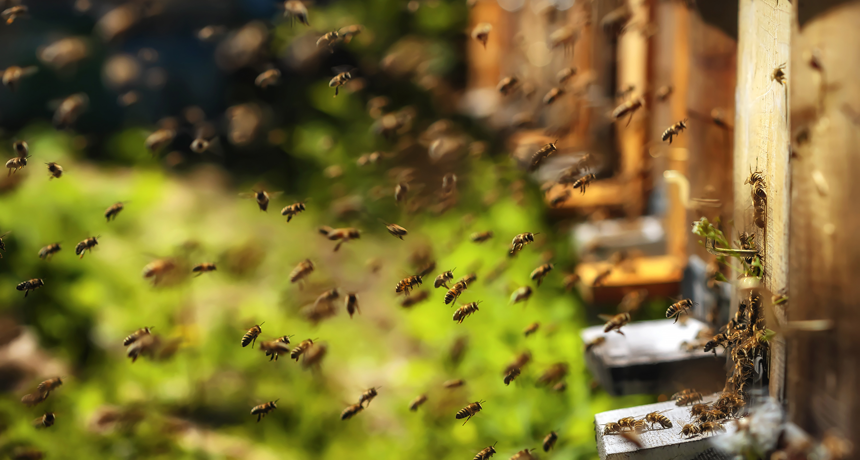
People have relied on honeybees and their products for thousands of years. Today, researchers still have much to learn from them.
Photografiero/iStockphoto
On a hot September day, Bernardo Niño stands in a yard surrounded by wooden boxes. Each is only a little bit bigger than a shoebox. Stacked one atop the other, they form towers a little more than a meter (about 3 feet) high. Each box holds about 10 screens inside wooden frames. This is where worker bees build honeycombs.
Hundreds of the bugs buzz around the mesh veil that obscures and protects Niño’s face. He calmly lifts a wooden frame from one of the hives. He holds it up to his face to get a closer look. Hundreds more busy worker bees scurry across the screen’s surface.
“There, this one isn’t looking good,” Niño says, pointing to a bee. There’s a tiny red spot on its body about the size of a pinhead. There’s something wrong with its wings, too. Normally long and flat, these wings are crumpled like a wad of paper.
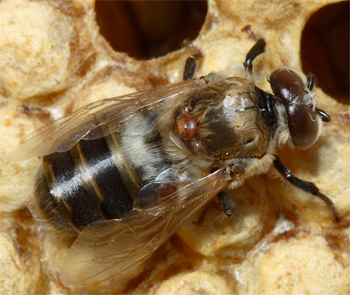
Niño knows his bees. A research technician, he works for a bee research laboratory at the University of California, Davis. Gently, the man pinches the worker bee with two fingers and lifts it off the frame.
The red spot on this bug is a varroa mite. This pest, Varroa destructor, latches onto honeybees and sucks their hemolymph — or insect blood — the same way that ticks or leeches can suck human blood. As a parasite, the mite lives off of its host, often sapping its energy.
Bees weakened by varroa mites are more likely to get other diseases. One of those diseases is called deformed wing virus. Niño points to the bee’s scrunched-up wings. That virus has left this insect unable to fly.
As many as 60,000 honeybees may share a single colony or hive. And an infestation of these mites can put the entire hive in danger. Last year, U.S. beekeepers lost almost half their hives to parasites and diseases. That adds up to a lot of dead bees. Experts worry that threats to bees could imperil many of our food supplies.
Honeybees pollinate at least 90 North American crops. These include apples, almonds, broccoli and carrots. Overall, bees and other pollinators help to produce more than one-third of the world’s food crops.
Honeybees have fascinated people since the dawn of civilization. Prehistoric rock drawings depict people hunting for honey. Chemical traces from ancient clay pots show that Stone Age people used beeswax. Even today, people still rely on the products bees make possible and the services these insects provide.
Given how important bees are to people, it should come as no surprise that scientists are working to protect honeybee health. Some researchers have also begun probing humanity’s long history with these helpful insects in hopes of improving modern medicine. Still others are studying bees to learn more about flight.
Fighting bee disease
As a research technician, Bernardo helps to do experiments that have been designed by a bee scientist. At the University of California, Davis, that scientist happens to be his wife, Elina Niño.
“I’m the boots on the ground, hands in the hive,” he says. “She’s the brains of the operation.”
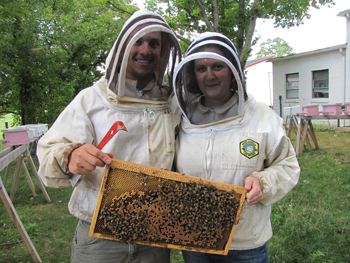
When California beekeepers have a problem, they come to Elina Niño. As head of the state’s beekeeping extension program, she looks for solutions. Extension programs are usually branches of universities that work with a state’s farmers.
“I guess I became an entomologist by accident,” Elina Niño jokes. In college, she had wanted to become a veterinarian. But watching forensic crime shows piqued her interest in bugs. She realized that those detectives sometimes used insects to help crack murder cases.
In graduate school, she studied whether a pesticide used to keep pesky flies off of cows might harm dung beetles on dairy farms. Those beetles are important to keeping a farm’s soil healthy. Soon, she moved from dung beetles to another helpful insect — the honeybee.
California beekeepers told her that the varroa mite has become their biggest problem. They asked for her help.
To protect their hives, beekeepers need to kill the mites. And pesticides containing human-made chemicals could kill those mites. But they also stunted the queen bees’ growth, Niño found. That’s important, because a queen that is small or weak may not reproduce as well as a healthy one. Plus the varroa mites quickly developed resistance to these pesticides so that they no longer killed the mites.
Elina Niño knew she needed to find chemicals that would kill the mites without harming the bees. For that, she turned to what are known as biopesticides. These are treatments made from chemicals found in nature.
Elina, Bernardo and the rest of their team are now testing different types of these biopesticides on 80 experimental beehives. Some of the new treatments contain essential oils. These are natural oils that give certain plants their scents. The team checks the hives to see not only if the new chemicals are vanquishing the mites, but also if they maypose any risks to the bees.
“One of the interesting things we’re seeing so far is that not all colonies respond to the same pesticide application in the same way,” Elina Niño says. She thinks genetic differences between honeybee colonies might explain those varying effects.
She doesn’t have all the answers yet. Her team left the hives alone while the bees rested this past winter. With spring, they’ll resume the study. In California, that’s not long. By late February, some bees were likely again out pollinating almond trees.
Bee-sized robots
To the human eye, a honeybee’s flitting from flower to flower may look simple. Yet the physics of bee flight is quite complex. Bees use short, choppy and extremely fast wing strokes compared to other insects their size. Unique flight muscles let them carry heavy pollen loads back to their hives.
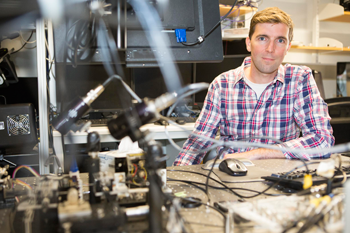
When Robert Wood wanted to make tiny, insect-sized robots fly, he looked to bees for help. Wood is a roboticist. He works at Harvard University in Cambridge, Mass., where he designs robots that have been inspired by nature. He observes nature to understand how organisms achieve a particular task. So looking to bees isn’t out of the ordinary for him.
A tiny machine can’t fly in the same way a large one does. After all, air flows very differently around a teensy insect wing than a giant airplane wing. So Wood had to create a new way of building wings before he could get his tiny robots to fly.
He looked at what biologists had learned about how bees and other insects fly. He wanted to know why each wing part works the way it does. “Is it shaped a certain way for thrust?” he wondered. “Or for some other, completely different reason that has nothing to do with flight, like confusing predators?” To find out, Wood probed which elements of wing design were important for flight — and which weren’t.
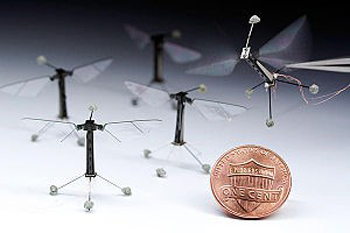
He used those data to build the RoboBee. This flying device is about the size of a U.S. penny. It can fly on its own using artificial muscles and sensors that mimic the eyes and antennae of a bee. RoboBee, though, doesn’t look like any kind of bee found in nature. It’s a mash-up of traits from different flying insects. It’s more like Frankenstein’s monster, Wood admits.
“The technology is still a long way from being practical,” says Wood. But the RoboBee is an early model to show that it’s possible to make robots this small fly.
Eventually, Wood wants to create artificial insects that can work together to complete a task. This would be similar to how bees in a colony cooperate to find food and protect the hive. A single bee is limited in what it can do, he says. But an entire hive can accomplish much.
Wood imagines many possibilities for a swarm of small, agile RoboBees. They might monitor traffic from the sky, search for survivors after natural disasters or even help real bees pollinate crops. “We’re starting with science-fiction ideas and trying to make them real,” Wood says.
Story continues below video
Unlocking honey’s health benefits
Tobias Olofsson’s research started not with science fiction, but childhood memories. His grandfather was a beekeeper. When he was young, Olofsson helped his grandpa collect honey from his beehives. His granddad sold the honey in the small Swedish town in which Olofsson grew up.
“My grandfather always had said that honey is really good for you if you have a cold or a sore throat,” Olofsson recalls.
Today, he works at Lund University in Sweden. There, he studies “friendly” bacteria. Not all bacteria are bad, this microbiologist explains. While some spread diseases, others help the human body stay healthy.
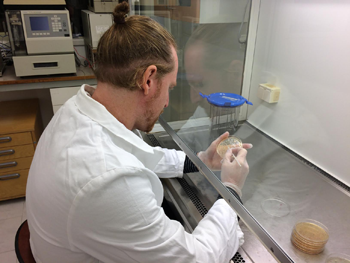
Olofsson knew that people had used honey to heal cuts and cure infections for thousands of years. “But we didn’t really know what it was about honey that gave it these beneficial properties,” he says.
To find out, he analyzed fresh honey from one of his grandpa’s hives. He found 13 new strains of a beneficial bacteria in it. These are called lactic acid bacteria. Olofsson ended up naming one of these new species after his granddad.
Bees have two stomachs. One is for eating. The other “honey” stomach stores nectar. This balloon-like organ stretches as a foraging bee collects nectar from flowers. Once back at the hive, the bee will spit the nectar up from this organ and deposit it into honeycomb cells. There it will become honey.
Lactic acid bacteria keep that honey from spoiling, Olofsson found. These microbes make several antibiotic-like substances. Those chemicals kill off mold and harmful germs that might otherwise ruin the honey.
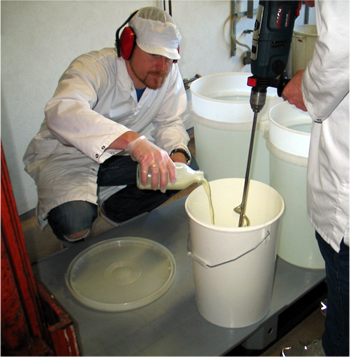
Might these bacteria also kill off the germs that make people sick? That’s what Olofsson wanted to know. So he took some of the lactic acid bacteria from the honey stomachs back to his lab. There, he tested these microbes against “superbugs” — the bacteria that have developed resistance to antibiotic drugs. This resistance is a growing problem. Infections that once were simple to cure have sometimes, in recent years, become severe or even deadly. Methicillin-resistant Staphylococcus aureus (MRSA) and vancomycin-resistant enterococcus (VRE) are two particularly bad examples.
The honeybee bacteria indeed killed these antibiotic-resistant germs, Olofsson showed. This got him excited. “I said to my grandfather, ‘I think this is really huge!’”
Next, the scientist made an ointment with the honey and the bee’s lactic acid bacteria. When tested on horses, it helped to close up slow-to-heal leg wounds. Olofsson plans to target human infections next. He’s already begun a project to test the ointment on people who also suffer from slow-healing leg wounds.
“There’s a lot of cool science happening inside a bee hive,” Olofsson says — “if you just look.”
This is one in a series on careers in science, technology, engineering and mathematics made possible with generous support from Arconic Foundation.







